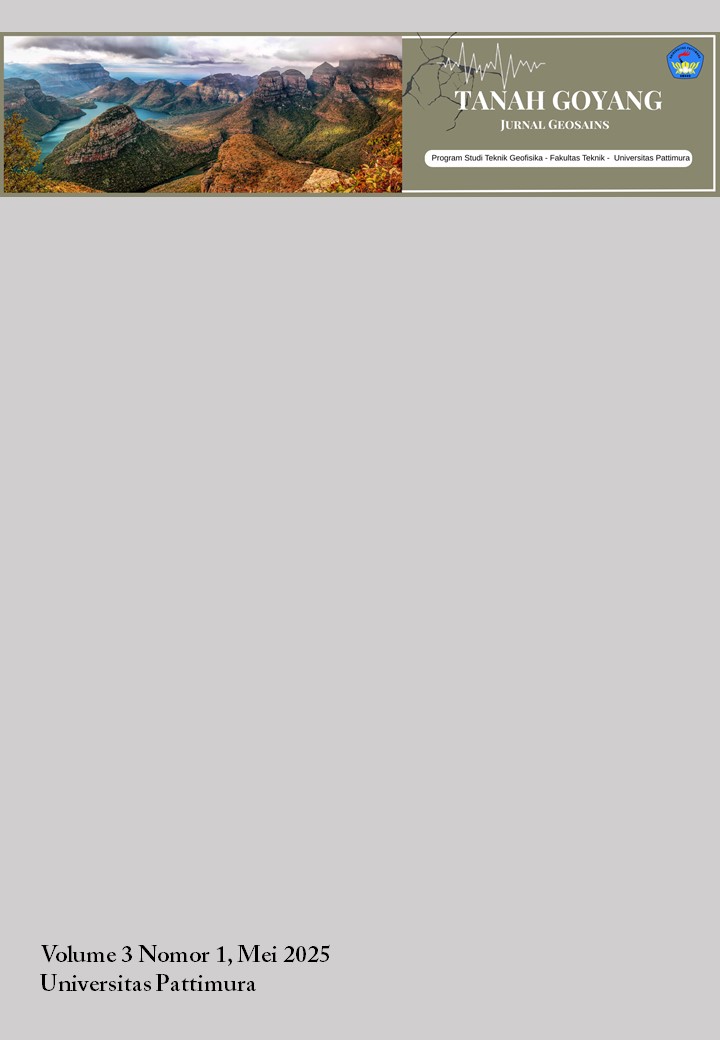Pembuatan Progam Inversi Gayaberat 2D Menggunakan Algoritma Levenberg-Marquadt
Abstract
This research implements 2D gravity data inversion using the Levenberg-Marquardt algorithm to analyze the sensitivity of modeling results to variations in initial models. Testing was conducted on two synthetic models, namely intrusion and fault, with density contrasts of 0.5 g/cm³ and 0.7 g/cm³ respectively. The inversion results demonstrate a critical dependence on the initial model. A homogeneous initial model produced distorted density estimates concentrated near the surface. Conversely, an initial model approximating the actual synthetic model yielded faster convergence and more accurate density distribution reconstruction. Comparative analysis revealed that the fault model achieved better fit, indicating the superior lateral resolution of the gravity method compared to its vertical resolution. These findings confirm that the accuracy of gravity data inversion heavily relies on geological constraints integrated through the initial model, where an informed approach produces more reliable subsurface models.
Downloads
References
Adhani, A. T., Anggitarizka, M., Meidina, Z., & Wibowo, R. C. (2022). Forward modelling on gravity anomalies fault model using MATLAB MathWorks. Jurnal Geocelebes, 6(2). https://doi.org/10.20956/geocelebes.v6i2.19157
Albazie, F. A. (2020). Pemodelan 3D data gravity untuk mengidentifikasi kemenerusan Kaldera Nongkojajar. Institut Teknologi Sepuluh Nopember.
Atef, H., Abd El-Gawad, A. M. S., Abdel Zaher, M., & Farag, K. S. I. (2016). The contribution of gravity method in geothermal exploration of southern part of the Gulf of Suez–Sinai region, Egypt. NRIAG Journal of Astronomy and Geophysics, 5(1), 173–185. https://doi.org/10.1016/j.nrjag.2016.02.005
Bahri, S., & Ramadhan, A. (2022). Pemodelan Pola Aliran Fluida 2D di Area Panas Bumi Menggunakan Metode Elemen Hingga Pendekatan Galerkin. CGANT JOURNAL OF MATHEMATICS AND APPLICATIONS, 3(2), 109-117. https://doi.org/10.19184/cgantjma.v3i2.81
Blakely, R. J. (1995). Potential Theory in Gravity and Magnetic Applications. Cambridge University Press.
Bogie, I., & Mackenzie, K. (1998). Volcanic facies analysis: A guide to recognizing and interpreting ancient volcanic successions. Journal of Volcanology and Geothermal Research, 92(1–2), 21–42.
Grandis, H. (2009). Pengantar pemodelan inversi geofisika. Himpunan Ahli Geofisika Indonesia, (Nomor 80).
Grandis, H., & Dahrin, D. (2014). Constrained two-dimensional inversion of gravity data. Journal of Mathematical and Fundamental Sciences, 46(1), 1–13. https://doi.org/10.5614/j.math.fund.sci.2014.46.1.1
Hidayat, H., Nanda, M. D., Lucki, G. M., Pusat, J., & Geologi, S. (2023). Pemodelan data gayaberat dengan metode inversi 3D, studi kasus: Cekungan Banyumas, Jawa Tengah. https://www.researchgate.net/publication/374082807
Latupeirissa, P. O. M., Bahri, S., & Alawiyah, S. (2024). Inversi gayaberat model Taiwani menggunakan Flower Pollination Algorithm (FPA). Tanah Goyang: Jurnal Geosains, 2(1), 13–21. https://doi.org/10.30598/tanahroyang.2.1.13-21
Levenberg, K. (1944). A method for the solution of certain non-linear problems in least squares. Quarterly of Applied Mathematics, 2(2), 164–168. https://doi.org/10.1090/qam/10666
Marquardt, D. W. (1963). An algorithm for least-squares estimation of nonlinear parameters. SIAM Journal on Applied Mathematics, 11(2), 431–441. https://doi.org/10.1137/0111030
Novianti, E., Realita, A., & Prastowo, T. (2024). Analisis dan interpretasi anomali gravitasi untuk identifikasi potensi sumber panas bumi di Gunung Arjuno-Welirang. Jurnal Inovasi Fisika Indonesia (IFI), 13(2), 13–24.
Rung-Arunwan, T., Siripunvaraporn, W., & Utada, H. (2022). The effect of initial and prior models on phase tensor inversion of distorted magnetotelluric data. Earth Planets Space, 74(51). https://doi.org/10.1186/s40623-022-01611-8
Said, U., Heriyanto, M., & Srigutomo, W. (2019). Perbandingan inversi least-square dengan Levenberg-Marquardt pada metode geomagnet untuk model crustal block. Prosiding SKF 2016.
Setyawan, A., Aqsa, M. K., Suseno, J. E., & Indriana, R. D. (2022). Gravity inversion modelling using simulated annealing and the Levenberg-Marquardt algorithm. International Journal of GEOMATE, 23(98), 109–116. https://doi.org/10.21660/2022.98.3518
Tandipajung, J., & Rachmadhan, H. D. (2024). Fasies Gunungapi Soputan, daerah Kilometer Tiga dan sekitarnya, Kecamatan Amurang, Kabupaten Minahasa Selatan, Sulawesi Utara. Journal Geological Processes, Risks, and Integrated Spatial Modeling, 2(2), 34–42.
Talwani, M., Worzel, J. L., & Landisman, M. (1959). Rapid computations for two-dimensional bodies with application to the Mendocino Submarine Fracture Zone. Journal of Geophysical Research, 64(1), 49–59.
Telford, W. M., Geldart, L. P., & Sheriff, R. E. (1990). Applied geophysics. Cambridge University Press.
Copyright (c) 2025 Husnaniah Kaharudin, Samsul Bahri, Darharta Dahrin

This work is licensed under a Creative Commons Attribution 4.0 International License.








1.png)

